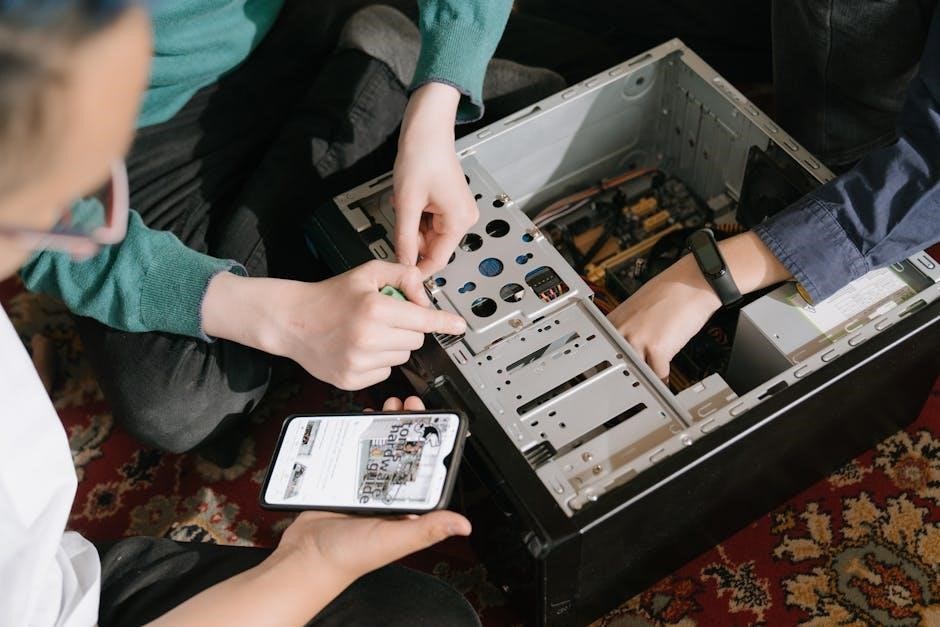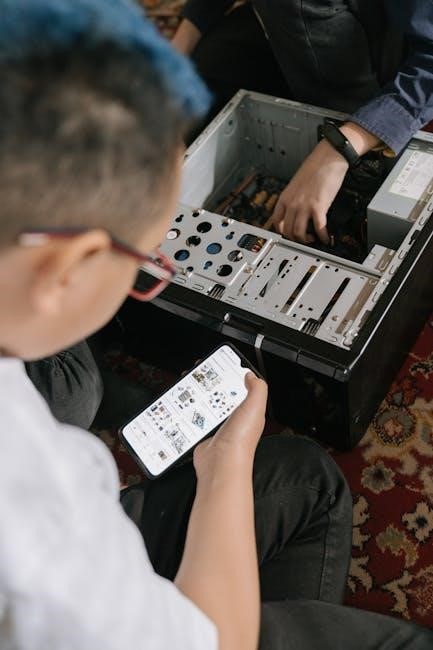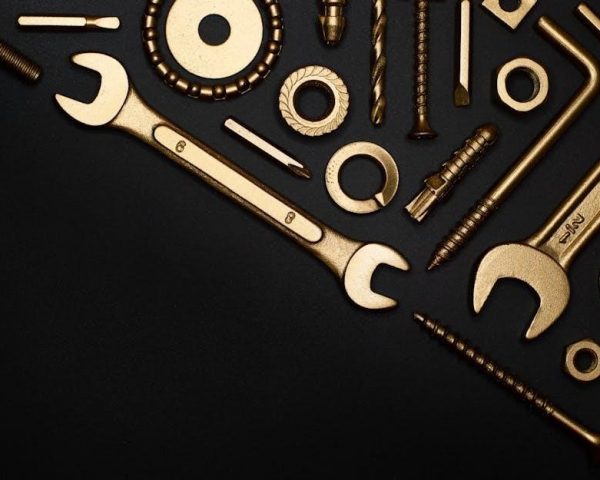Learn to identify and fix common issues with your Champion generator. This guide covers essential troubleshooting steps, from basic maintenance to advanced diagnostics, ensuring reliable power generation.
Discover how to address problems like faulty starts, power output issues, and overload scenarios. Regular maintenance and proper tool usage are key to preventing breakdowns and extending lifespan.
1.1 Importance of Regular Maintenance
Regular maintenance is crucial for preventing breakdowns and ensuring your Champion generator operates efficiently. It helps identify potential issues early, reducing repair costs and downtime. Proper upkeep includes oil checks, fuel system inspection, and air filter cleaning, which are vital for reliable power generation and extending the generator’s lifespan.
By following a routine maintenance schedule, you can avoid common problems like faulty starts or power output issues, ensuring your generator remains in optimal condition for years to come.
1.2 Overview of Common Issues
Common issues with Champion generators include failure to start, loss of power, and overload problems. These issues often stem from faulty spark plugs, blocked air filters, or improper fuel levels. Regular checks can prevent such problems, ensuring reliable performance and minimizing unexpected breakdowns during critical power needs.
Addressing these issues promptly helps maintain the generator’s efficiency and longevity.
1.3 Purpose of the Troubleshooting Guide
This guide is designed to help users identify and resolve common issues with their Champion generator. It provides step-by-step solutions, diagnostic tools, and maintenance tips to ensure optimal performance. By addressing problems early, users can extend the generator’s lifespan, avoid costly repairs, and maintain reliable power during emergencies or everyday use.
It empowers users to troubleshoot confidently and efficiently.

Understanding Your Champion Generator
Understanding your Champion generator’s operation, design, and features is crucial for effective troubleshooting. This knowledge helps identify issues quickly and ensures safe, efficient repairs and maintenance.
2.1 Key Components of the Generator
The Champion generator consists of an engine, alternator, fuel system, electrical panel, and cooling system. The engine powers the alternator, which generates electricity. The fuel system includes the tank and fuel lines, while the electrical panel manages power distribution and circuit protection. Understanding these components is essential for effective troubleshooting and maintenance.
2.2 Familiarizing Yourself with the Control Panel
Familiarizing yourself with the control panel is crucial for troubleshooting. It features circuit breakers, voltage meters, and receptacles. Understand the function of each indicator and switch, such as the power output light and choke switch. Knowing the layout ensures safe and efficient operation. Always refer to the owner’s manual for specific control panel details and locations.
2.3 Essential Tools for Troubleshooting
Essential tools for troubleshooting include a multimeter, screwdrivers, pliers, wrenches, and a flashlight; A multimeter is crucial for testing voltage and resistance. Safety gear like gloves and goggles is also necessary. Keep these tools handy to diagnose and repair issues efficiently. Always use the correct tool for the task to avoid further damage or injury.
Safety Precautions
Always turn off the generator and let it cool before troubleshooting. Disconnect from power sources and wear protective gear to ensure a safe working environment.
3.1 General Safety Guidelines
Always disconnect the generator from power sources before troubleshooting. Ensure the generator is turned off and cool to avoid burns. Wear protective gear, including gloves and safety glasses. Never work on the generator in wet conditions or while standing on damp surfaces. Keep loose clothing and long hair tied back to prevent accidents.
3.2 Proper Use of Protective Equipment
Always wear safety glasses or goggles to protect your eyes from debris. Use insulated gloves to prevent electrical shocks and cuts. Steel-toe boots safeguard feet from heavy objects. Ensure proper fit and condition of all protective equipment. Never troubleshoot without necessary gear, and inspect equipment before use.

Common Issues and Solutions
This section covers common problems like the generator not starting, no power output, or overload issues, providing practical solutions to get your unit running smoothly.
4.1 Generator Will Not Start
If your Champion generator won’t start, check for common issues like insufficient fuel, a faulty spark plug, or a dead battery. Ensure the choke is properly adjusted and the air filter is clean. Verify that the ignition switch is in the correct position and no safety features are engaged. Consult the manual for specific troubleshooting steps.
4.2 Generator Runs But Does Not Produce Power
If your Champion generator runs but doesn’t produce power, check for overloaded circuits or tripped breakers. Ensure all connections are secure and the voltage regulator is functioning. Verify the capacitor or alternator for damage. Consult the manual for specific electrical tests using a multimeter to identify faulty components like the AVR or wiring issues.
4.3 Overload or Circuit Breaker Issues
If the generator’s circuit breaker trips or shows overload, reduce the connected load immediately. Ensure the total power demand does not exceed the generator’s rated capacity. Check for short circuits or faulty appliances. Reset the breaker only after resolving the issue. Consult the manual for load management guidelines and test the circuit breaker with a multimeter if necessary.

Advanced Troubleshooting Techniques
Advanced techniques involve using tools like multimeters for electrical analysis and diagnosing fuel system malfunctions. These methods help identify complex issues systematically, ensuring efficient problem resolution.
5.1 Using a Multimeter for Electrical Checks
A multimeter is essential for diagnosing electrical issues. Set it to measure voltage, resistance, or continuity. Check the generator’s output receptacles, sensors, and wiring for faults. Verify voltage levels match specifications. Identify open circuits or short circuits by testing continuity. This tool helps pinpoint electrical failures accurately, ensuring effective troubleshooting and repairs.
5.2 Diagnosing Fuel System Problems
Inspect the fuel tank, lines, and filter for blockages or leaks. Ensure the fuel cap vents properly to prevent vacuum issues. Check for contaminated or stale fuel, which can clog the carburetor. Test the fuel valve and pump for proper operation. Use a pressure test kit to identify low fuel pressure or faulty components.
5.3 Identifying Faulty Spark Plugs or Ignition Systems
Inspect spark plugs for wear or fouling. Test ignition coil resistance with a multimeter. Check for spark at the plug using a spark tester. Ensure all connections are tight and free from damage. Replace worn or fouled plugs and faulty ignition components to restore proper engine function and reliable generator operation.
Error Codes and Alarms
Understand error codes and alarms to diagnose issues quickly; Refer to the manual for specific code meanings and follow reset procedures to restore normal operation.
6.1 Understanding Error Code Meanings
Champion generators display error codes to identify specific issues. These codes, like E01 or E02, indicate problems such as sensor malfunctions or battery faults. Refer to the user manual for exact meanings, as each code corresponds to a particular issue. Correct diagnosis ensures proper repairs and prevents further damage. Always follow the manual’s guidance for accurate troubleshooting.
6.2 Resetting Alarms and Error Codes
After addressing the underlying issue, reset the generator by turning it off, waiting 10 seconds, and restarting it. Check the control panel to ensure the alarm or error code has cleared. If the issue persists, consult the user manual for specific reset procedures, as some models may require additional steps to reset alarms properly.

Maintenance and Repair Tips
Regular maintenance ensures optimal performance and longevity. Always refer to the user manual for specific guidelines and safety precautions. Perform routine checks and repairs promptly.
- Inspect belts, hoses, and connections for wear or damage.
- Ensure proper lubrication and coolant levels are maintained.
7.1 Oil and Fuel Requirements
Always use the recommended oil type, typically SAE 30, for optimal performance. Ensure fuel is fresh and of the correct octane rating. Regular oil changes (every 50-100 hours) prevent engine damage. Check the manual for specific guidelines. Proper fuel storage and handling are crucial to maintain generator efficiency and longevity. Avoid using old or contaminated fuel to prevent issues.
7.2 Replacing Air Filters and Spark Plugs
Replace air filters every 100-150 hours or when dirty. Use genuine Champion parts for optimal performance. Spark plugs should be replaced annually or as specified in the manual. Inspect for wear or damage before installation. Proper replacement ensures efficient engine operation and prevents issues like rough starts or reduced power output. Always follow the manual’s guidelines.
7.3 Checking and Replacing the Battery
Inspect the battery terminals for corrosion and clean them if necessary. Check the battery voltage using a multimeter to ensure it meets the recommended levels. Replace the battery if it fails to hold a charge or shows signs of damage. Always use a genuine Champion battery or an equivalent recommended by the manufacturer. Consult the owner’s manual for specifications.

Troubleshooting Guide from the PDF
This section provides a detailed, step-by-step approach to diagnosing and resolving common issues. It includes error code explanations, advanced diagnostics, and solutions for specific problems, ensuring quick and effective repairs.
8.1 Step-by-Step Troubleshooting Process
Start by identifying the symptom, then consult the PDF guide for corresponding error codes. Check basic systems like fuel, oil, and air filters. Use tools like a multimeter to test electrical components. Follow the guide’s diagnostic flowchart to isolate issues; Perform repairs or adjustments as recommended, and test the generator to ensure the problem is resolved.
- Identify the issue based on symptoms or error codes.
- Refer to the PDF guide for specific troubleshooting steps.
- Test electrical and mechanical components systematically.
- Apply recommended fixes and verify resolution.
8.2 Detailed Solutions for Specific Problems
The PDF guide provides in-depth solutions for common issues, such as faulty starts, low power output, or overheating. Each problem is linked to step-by-step fixes, including checking the circuit breaker, ensuring proper fuel flow, and inspecting spark plugs. Detailed diagrams and part references help users identify and resolve issues efficiently.
- Check circuit breakers for overload issues.
- Ensure the choke is in the correct position for starting.
- Inspect spark plugs for damage or wear.

Champion Generator Parts and Accessories
This section highlights essential parts like air filters, spark plugs, and oil filters. It also provides guidance on purchasing genuine Champion accessories from authorized dealers or official websites.
- Ensure compatibility with your generator model.
- Refer to the official parts catalog for accuracy.
9.1 Identifying Replacement Parts
Identify replacement parts by referencing your generator’s model number in the official manual or manufacturer’s website. Key components include air filters, spark plugs, and oil filters. Ensure compatibility by cross-checking part numbers with Champion’s catalog to maintain performance and warranty validity. Always opt for genuine parts to avoid compromising your generator’s efficiency and safety standards.
- Use the model number for exact matches.
- Consult the user manual or Champion’s website.
9.2 Where to Purchase Genuine Parts
Purchase genuine Champion generator parts through the official Champion website, authorized dealers, or retailers like Home Depot. Ensure authenticity by verifying seller credibility, especially on platforms like eBay. Contact Champion customer support for direct assistance or to locate trusted suppliers. Genuine parts guarantee safety, performance, and warranty compliance.
- Official Champion website
- Authorized dealers
- Home Depot
- eBay (verified sellers)

Warranty and Support
Champion generators come with a 3-year limited warranty for residential use, covering defects in materials and workmanship. Extended warranties may be available for purchase.
- 3-year limited warranty
- Covers manufacturing defects
- Extended warranty options
- Contact Champion support for details
10.1 Understanding Your Warranty Coverage
Your Champion generator is backed by a 3-year limited warranty for parts and labor. This warranty covers defects in materials and workmanship under normal use. Exclusions may apply for misuse or improper maintenance. Always consult your warranty documentation for full details and terms.
- 3-year limited warranty
- Covers parts and labor
- Exclusions for misuse
- Review documentation for terms
10.2 Contacting Champion Customer Support
For assistance, contact Champion Customer Support via phone, email, or live chat on their official website. Phone support is available Monday-Friday, 8 AM-5 PM PST. Visit their website for contact details and additional resources to help resolve your generator issues efficiently.
- Phone: Available Monday-Friday
- Email: Direct support option
- Live Chat: Quick online assistance
- Website: Visit for contact info

Preventative Maintenance Schedule
Regular maintenance ensures optimal performance and extends the lifespan of your generator. Follow a structured schedule to check and service critical components, preventing potential issues before they arise. Proper upkeep enhances reliability and safety, ensuring your generator is always ready for use. Consistency is key to maintaining efficiency and avoiding costly repairs. Stay proactive with routine checks and services to keep your generator in top condition. Always refer to the official Champion guide for specific maintenance intervals tailored to your model. Adhering to the schedule ensures compliance with warranty terms and guarantees optimal operation during power outages or emergencies. Regular servicing also helps identify and address minor issues before they escalate, saving time and resources in the long run. By prioritizing maintenance, you ensure your generator remains a dependable power source for years to come. Detailed maintenance timelines and procedures are outlined in the Champion troubleshooting guide, providing a clear roadmap for generator care. Familiarize yourself with these recommendations to maximize your generator’s performance and longevity. Consistent upkeep not only prevents breakdowns but also ensures safe operation, protecting both the unit and its users. Remember, a well-maintained generator is a reliable one, capable of delivering consistent power when needed most. Regular inspections and timely servicing are essential for maintaining peak performance and addressing potential issues early. Stay ahead of problems with a proactive maintenance approach, ensuring your Champion generator continues to function efficiently and effectively. Schedule regular check-ups and follow the guidelines provided to keep your generator in excellent working condition. Proper maintenance is the cornerstone of generator longevity and performance. Always adhere to the recommended schedule to enjoy uninterrupted power supply and extend the life of your equipment. Regular servicing not only prevents unexpected failures but also ensures that your generator operates safely and at maximum capacity. Stay committed to routine maintenance to get the most out of your Champion generator.
- Follow a structured maintenance schedule
- Check and service critical components
- Prevent potential issues before they arise
- Ensure optimal performance and safety
- Refer to the official Champion guide
- Adhere to recommended maintenance intervals
- Ensure warranty compliance
- Maximize generator longevity and reliability
11.1 Monthly Checks and Services
Perform monthly checks to ensure your Champion generator operates efficiently. Inspect the oil level, air filter, and fuel for cleanliness and adequacy. Check battery terminals for corrosion and ensure all connections are secure. Use a multimeter to verify voltage output and inspect the spark plug for wear. Clean or replace components as needed to maintain optimal performance. Consult the manual for specific guidelines.
- Inspect oil level and top up if necessary
- Check air filter for cleanliness or damage
- Verify fuel quality and quantity
- Clean or replace spark plugs
- Check battery terminals for corrosion
- Inspect all connections for tightness
- Use a multimeter to test voltage output
- Clean exterior and internal components
11.2 Annual Maintenance Requirements
Annual maintenance is crucial for ensuring your Champion generator runs reliably. Replace the oil and oil filter, and perform a thorough inspection of the fuel system. Clean or replace the air filter, and inspect the spark plugs and ignition system. Check the battery terminals and charge level, and ensure all connections are secure. Refer to the manual for detailed annual service procedures.
- Replace oil and oil filter
- Clean or replace air filter
- Inspect and clean spark plugs
- Check battery charge and terminals
- Inspect fuel system for leaks or damage
- Verify all electrical connections

Storing Your Champion Generator
Drain fuel, add stabilizer, and disconnect the battery before storage. Store in a cool, dry place away from direct sunlight to prevent damage and maintain performance.
12.1 Proper Storage Techniques
Drain fuel and add a fuel stabilizer to prevent degradation. Clean the generator thoroughly, cover it with a breathable material, and store in a dry, cool, well-ventilated area. Ensure the battery is disconnected and terminals are protected. Avoid direct sunlight and moisture exposure to maintain optimal condition and longevity during storage periods.
12.2 Preparing for Long-Term Storage
Drain the fuel tank and add a fuel stabilizer to prevent corrosion. Clean the generator thoroughly and apply rust-inhibiting oil to metal parts. Disconnect the battery and store it separately in a cool, dry place. Secure all loose components and cover the generator with a durable, weather-resistant cover to protect it from dust and moisture.
Troubleshooting Electrical Output Issues
Identify issues causing electrical output problems. Check the circuit breaker, inspect wiring for damage, and test AC output with a multimeter to ensure proper voltage.
13.1 Checking for Faulty Wiring
Inspect the generator’s wiring for signs of damage, wear, or corrosion. Look for frayed cords, loose connections, or burn marks. Use a multimeter to test for continuity and voltage drops. Ensure all terminals are secure and clean. Replace any damaged wires or connections to restore proper electrical flow and prevent further issues.
13.2 Testing AC Output with a Multimeter
Set your multimeter to AC voltage mode. Insert the black probe into the generator’s neutral outlet and the red probe into the live outlet. Compare the reading to the generator’s rated voltage. A deviation indicates wiring or capacitor issues. Ensure the generator is running and under load for accurate results.
Common Mistakes to Avoid
- Avoid overloading the generator beyond its rated capacity to prevent damage and ensure safe operation. Regularly check the load to maintain optimal performance and longevity.
14.1 Overloading the Generator
- Overloading the generator can cause overheating, damage to internal components, and premature wear. Always check the power ratings of connected devices and ensure the total load does not exceed the generator’s capacity. Use a load calculator if necessary, and prioritize essential appliances to avoid overloading.
14.2 Ignoring Routine Maintenance
- Ignoring routine maintenance can lead to reduced efficiency, increased wear on components, and eventual system failure. Regular oil changes, filter replacements, and inspections are crucial to ensure optimal performance and extend the generator’s lifespan. Neglecting these tasks can result in costly repairs and downtime when the generator is needed most.
Additional Resources
Access the official Champion Generator Troubleshooting Guide PDF for detailed instructions; Explore online forums and Champion’s official website for further support and repair guidance.
15.1 Downloading the Official PDF Guide
The official Champion Generator Troubleshooting Guide PDF is available for download on Champion Power Equipment’s website. It provides comprehensive repair and maintenance instructions, ensuring you can diagnose and fix issues efficiently. Visit the official site, navigate to the support section, and download the PDF guide for detailed step-by-step solutions and diagrams.
15.2 Recommended Online Forums and Communities
Joining online forums and communities, such as Reddit’s r/Generators or specialized DIY repair groups, can provide valuable insights and solutions for your Champion generator. These platforms often feature discussions from experienced users and technicians, offering practical advice and troubleshooting tips. Participating in these communities can help you resolve issues quickly and effectively.


